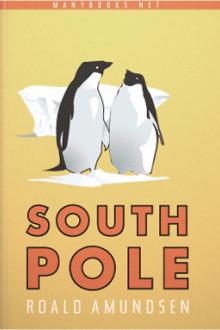A Book of Discovery by M. B. Synge (the snowy day read aloud txt) 📕

- Author: M. B. Synge
- Performer: -
Book online «A Book of Discovery by M. B. Synge (the snowy day read aloud txt) 📕». Author M. B. Synge
Though England claimed the discovery of this Newfoundland, the Portuguese declared that one of their countrymen, Cortereal—a gentleman of the royal household—had already discovered the "land of the cod-fish" in 1463. But then had not the Vikings already discovered this country five hundred years before?
All the nations of Europe were now straining westward for new lands to conquer. French sailors had fished in the seas washing the western coast of North America; Verazzano, a Florentine, in the service of France, had explored the coast of the United States, and a good deal was known when Jacques Cartier, a Frenchman, steps upon the scene and wins for his country a large tract of land about the river St. Lawrence. His object was to find a way across America to Cathay. With two little ships of sixty tons and sixty-one "chosen men," Cartier left St. Malo on 20th April 1534. With prosperous weather he tells us he made the coast of Newfoundland in three weeks, which would mean sailing over one hundred miles a day. He was a little too early in the season, for the easterly winds which had helped him on his way had blocked the east coast of the island with Arctic ice. Having named the point at which he first touched land Cape Bona Vista, he cruised about till, the ice having melted, he could sail down the straits of Belle Isle between the mainland of Labrador and Newfoundland, already discovered by Breton fishermen. Then he explored the now familiar Gulf of St. Lawrence—the first European to report on it. All through June the little French ships sailed about the Gulf, darting across from island to island and cape to cape. Prince Edward Island appealed to him strongly. "It is very pleasant to behold," he tells us. "We found sweet-smelling trees as cedars, yews, pines, ash, willow. Where the ground was bare of trees it seemed very fertile and was full of wild corn, red and white gooseberries, strawberries, and blackberries, as if it had been cultivated on purpose." It now grew hotter, and Cartier must have been glad of a little heat. He sighted Nova Scotia and sailed by the coast of New Brunswick, without naming or surveying them. He describes accurately the bay still called Chaleur Bay: "We named this the Warm Bay, for the country is warmer even than Spain and exceedingly pleasant." They sailed up as far as they could, filled with hope that this might be the long-sought passage to the Pacific Ocean. Hope Cape they named the southern point, but they were disappointed by finding only a deep bay, and to-day, by a strange coincidence, the point opposite the northern shore is known as Cape Despair—the Cap d'Espoir of the early French mariners. Sailing on to the north amid strong currents and a heavy sea, Cartier at last put into a shelter (Gaspé Bay). Here, "on the 24th of July, we made a great cross thirty feet high, on which we hung up a shield with three fleurs-de-lis, and inscribed the cross with this motto: 'Vive le roi de France.' When this was finished, in presence of all the natives, we all knelt down before the cross, holding up our hands to heaven and praising God."
JACQUES CARTIER JACQUES CARTIER.From an old pen drawing at the Bibliothèque Nationale, Paris.
Storms and strong tides now decided Cartier to return to France. He knew nothing of the Cabot Strait between Newfoundland and the land afterwards called Nova Scotia, so he guided his little ships right through the Straits of Belle Isle, and after being "much tossed by a heavy tempest from the east, which we weathered by the blessing of God," he arrived safely home on 5th September, after his six months' adventure. He was soon commissioned to continue the navigation of these new lands, and in May 1535 he safely led three ships slightly larger than the last across the stormy Atlantic. Contrary winds, heavy gales, and thick fogs turned the voyage of three weeks into five—the ships losing one another not to meet again till the coast of Labrador was reached. Coasting along the southern coast, Cartier now entered a "very fine and large bay, full of islands, and with channels of entrance and exit in all winds." Cartier named it "Baye Saint Laurens," because he entered it on 10th August—the feast of St. Lawrence.
Do any of the English men and women who steam up the Gulf of St. Lawrence in the great ocean steamers to-day, on their way to Canada, ever give a thought to the little pioneer French ships that four hundred years ago thought they were sailing toward Cathay?
"Savages," as Cartier calls the Indians, told him that he was near the mouth of the great river Hochelaga (now the St. Lawrence), which became narrower "as we approach towards Canada, where the water is fresh."
"On the first day of September," says Cartier, "we set sail from the said harbour for Canada." Canada was just a native word for a town or village. It seems strange to read of the "lord of Canada" coming down the river with twelve canoes and many people to greet the first white men he had ever seen; strange, too, to find Cartier arriving at "the place called Hochelaga—twenty-five leagues above Canada," where the river becomes very narrow, with a rapid current and very dangerous on account of rocks. For another week the French explorers sailed on up the unknown river. The country was pleasant, well-wooded, with "vines as full of grapes as they would hang." On 2nd October, Cartier arrived at the native town of Hochelaga. He was welcomed by hundreds of natives,—men, women, and children,—who gave the travellers as "friendly a welcome as if we had been of their own nation come home after a long and perilous absence." The women carried their children to him to touch them, for they evidently thought that some supernatural being had come up from the sea. All night they danced to the light of fires lit upon the shore.
CANADA AND THE RIVER ST. LAWRENCE, SHOWING QUEBEC (KEBEC) CANADA AND THE RIVER ST. LAWRENCE, SHOWING QUEBEC (KEBEC).From Lescarbot's Histoire de la Nouvelle France, 1609.
The next morning Cartier, "having dressed himself splendidly," went ashore with some of his men. All were well armed, though the natives seemed peacefully disposed. They marched along a well-beaten track to the Indian city, which stood in the midst of cultivated fields of Indian corn and maize. Again the inhabitants met them with signs of joy and gladness, and the King was carried shoulder high, seated on a large deer-skin with a red wreath round his head made of the skins of hedgehogs instead of a crown.
A curious scene then took place. The King placed his crown on the head of the French explorer, before whom he humbled himself as before a god. Thus evidently did the people regard him, for they brought to him their blind, their lame, and their diseased folk that he might cure them. Touched with pity at the groundless confidence of these poor people, Cartier signed them with the sign of the cross. "He then opened a service book and read the passion of Christ in an audible voice, during which all the natives kept a profound silence, looking up to heaven and imitating all our gestures. He then caused our trumpets and other musical instruments to be sounded, which made the natives very merry."
Cartier and his men then went to the top of the neighbouring mountain. The extensive view from the top created a deep impression on the French explorer; he grew enthusiastic over the beauty of the level valley below and called the place Mont Royal—a name communicated to the busy city of Montreal that lies below.
Winter was now coming on, and Cartier decided against attempting the homeward voyage so late in the year; but to winter in the country he chose a spot between Montreal and Quebec, little thinking what the long winter months would bring forth. The little handful of Frenchmen had no idea of the severity of the Canadian climate; they little dreamt of the interminable months of ice and snow when no navigation was possible. Before Christmas had come round the men were down with scurvy; by the middle of February, "out of one hundred and ten persons composing the companies of our three ships, there were not ten in perfect health. Eight were dead already. The sickness increased to such a pitch that there were not above three sound men in the whole company; we were obliged to bury such as died under the snow, as the ground was frozen quite hard, and we were all reduced to extreme weakness, and we lost all hope of ever returning to France." From November to March four feet of snow lay upon the decks of their little ships. And yet, shut up as they were in the heart of a strange and unknown land, with their ships icebound and nought but savages around, there is no sound of murmur or complaint. "It must be allowed that the winter that year was uncommonly long" is all we hear.
NEW FRANCE, SHOWING NEWFOUNDLAND, LABRADOR, AND THE ST. LAWRENCE NEW FRANCE, SHOWING NEWFOUNDLAND, LABRADOR, AND THE ST. LAWRENCE.From Jocomo di Gastaldi's Map, about 1550. The "Isola de Demoni" is Labrador, and "Terra Nuova" and the islands south of it make up Newfoundland. The snaky-like line represents a sandbank, which was then thought, and agreed, to be the limit of fishing. Montreal (Port Real) will be noticed on the coast.
May found them free once more and making for home with the great news that, though they had not found the way to Cathay, they had discovered and taken a great new country for France.
A new map of the world in 1536 marks Canada and Labrador, and gives the river St. Lawrence just beyond Montreal. A map of 1550 goes further, and calls the sea that washes the shores of Newfoundland and Labrador the "Sea of France," while to the south it is avowedly the "Sea of Spain."
THE DAUPHIN MAP OF THE WORLD. MADE BY PIERRE DESCELIERS, 1546, TO THE ORDER OF FRANCIS I., FOR THE DAUPHIN (HENRI II. OF FRANCE) THE "DAUPHIN" MAP OF THE WORLD. MADE BY PIERRE DESCELIERS, 1546, TO THE ORDER OF FRANCIS I., FOR THE DAUPHIN (HENRI II. OF FRANCE).This map gives a remarkably clear and interesting view of geographical knowledge in the first half of the sixteenth century. (It is to be noted that all objects on one side of the Equinoctial are reversed.)
England was now awaking from her sleep—too late to possess the Spice Islands—too late for India and the Cape of Good Hope—too late, it would seem, for the New World. The Portuguese held the eastern route, the Spaniards the western route to the Spice Islands. But what if there were a northern route? All ways apparently led to Cathay. Why should England not find a way to that glorious land by taking a northern course?
"If the seas toward the north be navigable we may go to these Spice Islands by a shorter way than Spain and Portugal," said Master Thorne of Bristol—a friend of the Cabots.
"But the northern seas are blocked with ice





Comments (0)